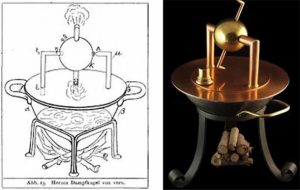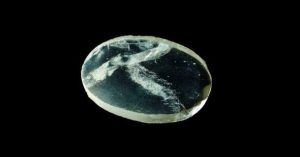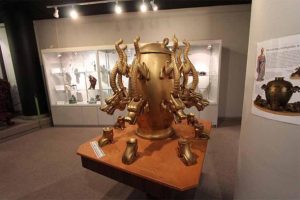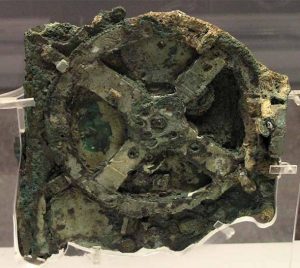Ancient Marvels: ten incredible inventions made earlier than expected

Dating back thousands of years are numerous examples of amazing inventions and ancient technology that leave us awe-struck at the knowledge and wisdom held by people of our past. They were the result of incredible advances in engineering and innovation as new, powerful civilizations emerged and came to dominate the ancient world.
These advances stimulated societies to adopt new ways of living and governance, as well as new ways of understanding their world. However, many ancient inventions were forgotten, lost to the pages of history, only to be re-invented millennia later. Here we feature ten amazing inventions and examples of technology that demonstrate the ingenuity of our ancient ancestors.
Amazing Inventions #1. The Ancient Invention of the Steam Engine by the Hero of Alexandria

Ancient illustration and modern-day replica of a steam engine. (Ancient Origins)
Heron Alexandrinus, otherwise known as the Hero of Alexandria, was a 1st century Greek mathematician and engineer who is known as the first inventor of the steam engine. His steam powered device was called the aeolipile, named after Aiolos, God of the winds.
6 Ways Roman Engineers Were Way Ahead of Their Time
Ten Things the Ancients Did Better than Us
The aeolipile consisted of a sphere positioned in such a way that it could rotate around its axis. Nozzles opposite each other would expel steam and both of the nozzles would generate a combined thrust resulting in torque, causing the sphere to spin around its axis. The rotation force sped up the sphere up to the point where the resistance from traction and air brought it to a stable rotation speed.
In this amazing invention, the steam was created by boiling water under the sphere – the boiler was connected to the rotating sphere through a pair of pipes that at the same time served as pivots for the sphere. The replica of Heron’s machine could rotate at 1,500 rounds per minute with a very low pressure of 1.8 pounds per square inch. The remarkable device was forgotten and never used properly until 1577, when the steam engine was “re-invented” by the philosopher, astronomer and engineer, Taqu al-Din.
Amazing Inventions #2. The Assyrian Nimrud Lens

The Nimrud lens, one of the most amazing inventions in ancient history, is thought to be the oldest telescope in the world. (The British Museum / CC BY-NC-SA 4.0)
No list of amazing inventions from the ancient past would be complete without including the Nimrud lens, a 3,000-year-old piece of rock crystal, which was unearthed by Sir John Layard in 1850 at the Assyrian palace of Nimrud, in modern-day Iraq. The Nimrud lens (also called the Layard lens) was made from natural rock crystal and is a slightly oval in shape. Roughly ground, perhaps on a lapidary wheel, it has a focal point about 11 centimeters from the flat side, and a focal length of about 12 cm.
The characteristics of the Nimrud lens make it equivalent to a 3× magnifying glass (combined with another lens, it could achieve much greater magnification). The surface of the lens has twelve cavities that were opened during grinding, which would have contained naptha or some other fluid trapped in the raw crystal.
Since its discovery over a century ago, scientists and historians have debated its use, with some suggesting it was used as a magnifying glass, and others maintaining it was a burning-glass used to start fires by concentrating sunlight. However, prominent Italian professor Giovanni Pettinato proposed the lens was used by the ancient Assyrians as part of a telescope, which would explain how the Assyrians knew so much about astronomy.
According to conventional perspectives, the telescope was invented by Dutch spectacle maker, Hans Lippershey in 1608 AD, and Galileo was the first to point it to the sky and use it to study the cosmos. But even Galileo himself noted that the so-called “ancients” were aware of telescopes long before him. While lenses were around before the Nimrud lens, Pettinato believes this was one of the first to be used in a telescope.
3. The Oldest Calendar in Scotland

The Mesolithic calendar system discovered at Warren Field in Aberdeenshire, Scotland, is one of the most amazing inventions in history. (Internet Archaeology / CC BY-SA 3.0)
Research carried out last year on an ancient site excavated by the National Trust for Scotland in 2004 revealed that it contained a sophisticated calendar system that is approximately 10,000 years old, making it the oldest calendar ever discovered in the world. The site – at Warren Field, Crathes, Aberdeenshire – contains a 50-meter-long row of twelve pits which were created by Stone Age Britons and which were in use from around 8000 BC (the early Mesolithic period) to around 4,000 BC (the early Neolithic).
The pits represent the months of the year as well as the lunar phases of the moon. They were formed in a complex arc design in which each lunar month was divided into three roughly ten-day weeks – representing the waxing moon, the full moon and the waning moon. It also allowed the observation of the mid-winter sunrise so that the lunar calendar could be recalibrated each year to bring it back in line with the solar year. The entire arc represents a whole year and may also reflect the movements of the moon across the sky.
Amazing Inventions #4. Ancient Roman Concrete was Far Superior to Our Own

Roman concrete is one of the most amazing inventions to have come out of the Roman Empire. (Lawrence Berkeley National Laboratory)
Scientists studying the composition of Roman concrete, which has been submerged under the Mediterranean Sea for the last 2,000 years, discovered that it was superior to modern-day concrete in terms of durability. Surprisingly, they also concluded that it was also less damaging to the environment.
The Romans made concrete by mixing lime and volcanic rock. For underwater structures, the combination of lime and volcanic ash with seawater instantly triggered a chemical reaction in which the lime incorporated molecules into its structure and reacted with the ash to cement the whole mixture together.
Why Was Roman Concrete So Durable? Scientists Say It Could Heal Itself
A Step Closer to Finding the Recipe for Ancient Rome’s Rock-Solid Super-Concrete
Analysis of the concrete found that it produces a significantly different compound to modern day cement, which is an incredibly stable binder. In addition, the ancient concrete contains the ideal crystalline structure of Tobermorite, which has a greater strength and durability than the modern equivalent.
Finally, microscopic studies identified other minerals in the ancient concrete which show potential application for high-performance concretes, including the encapsulation of hazardous wastes. “In the middle 20th century, concrete structures were designed to last 50 years,” said scientist Paulo Monteiro. “Yet Roman harbor installations have survived 2,000 years of chemical attack and wave action underwater.”
Amazing Inventions #5. 2,000-Year-Old Metal Coatings Superior to Today’s Standards

Medieval artisans have been credited with one of the most amazing inventions thanks to their developing of a type of gilding superior to modern standards. (American Chemical Society)
Research has shown that artisans and craftsmen 2,000 years ago used a form of ancient technology for applying thin films of metal to statues and other items. Through analysis they have found that this metal coating was superior to today’s standards for producing DVDs, solar cells, electronic devices and other products.
Fire gilding and silvering are age-old mercury-based processes used to coat the surface items such as jewels, statues and amulets with thin layers of gold or silver. From a technological point of view, what the ancient gilders achieved 2,000 years ago, was to make the metal coatings incredibly thin, adherent and uniform, which saved expensive metals and improved its durability. This amazing invention is something which has never been achieved to the same standard today.
Apparently without any knowledge about the chemical–physical processes, ancient craftsmen systematically manipulated metals to create spectacular results. They developed a variety of techniques, including using mercury like a glue to apply thin films of metals to objects. The findings demonstrate that there was a far higher level of understanding and knowledge of advanced concepts and techniques in our ancient past than what they are given credit for.
Amazing Inventions #6. The Incredible 2,000-Year-Old Earthquake Detector

A modern replica of Zhang Heng’s famous seismoscope, one of the most amazing inventions from ancient history. (CC BY 2.0 DEED)
Although we still cannot accurately predict earthquakes, we have come a long way in detecting, recording and measuring seismic shocks. What many don’t realize is that this process began nearly 2,000 years ago, with the invention of the first seismoscope in 132 AD by a Chinese astronomer, mathematician, engineer and inventor called Zhang (‘Chang’) Heng.
A fundamental addition to our list of ancient and amazing inventions, the device was remarkably accurate in detecting earthquakes from afar and did not rely on shaking or movement in the location where the device was situated.
Zhang’s seismoscope was a giant bronze vessel, resembling a samovar almost 6 feet (1.8 m) in diameter. Eight dragons snaked face-down along the outside of the barrel, marking the primary compass directions. In each dragon’s mouth was a small bronze ball. Beneath the dragons sat eight bronze toads, with their broad mouths gaping to receive the balls. The sound of the ball striking one of the eight toads would alert observers to the earthquake and would give a rough indication of the earthquake’s direction of origin.
In 2005, scientists in Zengzhou, China (which was also Zhang’s hometown) managed to replicate Zhang’s seismoscope and used it to detect simulated earthquakes based on waves from four different real-life earthquakes in China and Vietnam. The seismoscope detected all of them. As a matter of fact, the data gathered from the tests corresponded accurately with that gathered by modern-day seismometers!
Amazing Inventions #7. Mythical Sunstone Used as Ancient Navigational Device
An ancient Norse myth described a magical gem used to navigate the seas, which could reveal the position of the sun when hidden behind clouds or even before dawn or after sunset. Now it appears the myth is in fact true.
In March 2013, a team of scientists announced that a unique calcite crystal, which was found in the wreck of an Elizabethan ship sunk off the Channel Islands, contains properties consistent with the legendary Viking sunstone and that shards of the crystal can indeed act as a remarkably precise navigational aid. An amazing invention indeed!
According to the researchers, the principle behind the sunstone relies on its unusual property of creating a double refraction of sunlight, even when it is obscured by cloud or fog. By turning the crystal in front of the human eye until the darkness of the two shadows are equal, the sun’s position can be pinpointed with remarkable accuracy.
Amazing Inventions #8. The Baghdad Battery

The Baghdad Battery. (Ancient Origins)
The Baghdad Battery, sometimes referred to as the Parthian Battery, is a clay pot which encapsulates a copper cylinder. Suspended in the center of this cylinder—but not touching it—is an iron rod. Both the copper cylinder and the iron rod are held in place with an asphalt plug.
These artifacts (more than one was found) were discovered during the 1936 excavations of the old village Khujut Rabu, near Baghdad. The village is considered to be about 2,000 years old and was built during the Parthian period (250BC to 224 AD).
Although it is not known exactly what the use of such a device would have been, the name “Baghdad Battery” comes from one of the prevailing theories established in 1938. At this time, Wilhelm Konig, the German archaeologist who performed the excavations, examined the battery and concluded that this device was an ancient electric battery.
After the Second World War, Willard Gray, an American working at the General Electric High Voltage Laboratory in Pittsfield, built replicas and, filling them with an electrolyte, found that the devices could produce 2 volts of electricity. The question remains, if it really was a battery, what was it used to power?
Amazing Inventions #9. 1,600-Year-Old Goblet Reveals Romans Used Nanotechnology

Late Roman drinking goblet provides evidence of early knowledge of nanotechnology. (The Trustees of the British Museum / CC BY-NC-SA 4.0)
The Lycurgus Cup, as it is known due to its depiction of a scene involving King Lycurgus of Thrace, is a 1,600-year-old jade green Roman chalice that changes color depending on the direction of the light upon it. It has baffled scientists ever since the glass chalice was acquired by the British Museum in the 1950s.
If you’re wondering why a jade goblet has been included in our list of amazing inventions, it has to do with the fact that for decades scientists were unable to figure out why the cup appeared jade green when lit from the front but blood red when lit from behind.
6 Advanced Ancient Inventions Beyond Modern Understanding
Ancient Magic: The Illusions Created in Temples by Amazing Inventions
The mystery was finally solved in 1990, when researchers in England scrutinized broken fragments under a microscope and discovered that the Roman artisans were nanotechnology pioneers: they had impregnated the glass with particles of silver and gold, ground down until they were as small as 50 nanometers in diameter, less than one-thousandth the size of a grain of table salt.
The work was so precise that there is no way that the resulting effect was an accident. In fact, the exact mixture of the metals suggests that the Romans had perfected the use of nanoparticles. When hit with light, electrons belonging to the metal flecks vibrate in ways that alter the color depending on the observer’s position.
Amazing Inventions #10. The Ancient Antikythera Mechanism

The ancient Antikythera Mechanism has baffled scientists for decades. (Marsyas / CC BY-SA 3.0)
The Antikythera mechanism was discovered in 1900 during the recovery of a shipwreck off the Greek island Antikythera, in waters almost 200 feet (60 meters) deep. It is a metallic device which consists of a complex combination of gears and dates back to the 2nd century BC.
The Antikythera mechanism is one of the most amazing inventions and mechanical devices ever discovered from the ancient world. For decades, scientists have utilized the latest technology in attempts to decipher its functionality; however, due to its complexity, its true purpose and function remained elusive.
Nevertheless, in the last few years scientists appear to have solved the mystery as to precisely how this incredible piece of technology once worked. Peter Lynch, professor of meteorology at University College Dublin, explains:
“The mechanism was driven by a handle that turned a linked system of more than 30 gear wheels… The gears were coupled to pointers on the front and back of the mechanism, showing the positions of the sun, moon and planets as they moved through the zodiac. An extendable arm with a pin followed a spiral groove, like a record player stylus. A small sphere, half white and half black, indicated the phase of the moon. Even more impressive was the prediction of solar and lunar eclipses.”
Amazingly, the device even included a dial to indicate which of the Pan-Hellenic games would take place each year, with the Olympics occurring every fourth year. Just one small cog out of 30 remains a mystery and it is hoped that further research can place this last piece in the puzzle.